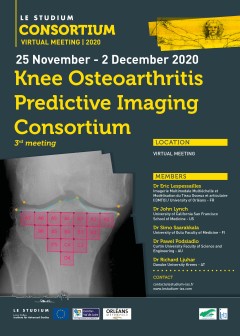Knee Osteoarthritis Predictive Imaging Consortium
3rd meeting
VIRTUAL MEETING
France
Presentation
MEMBERS
- Dr Eric Lespessailles
Imagerie Multimodale Multiéchelle et Modélisation du Tissu Osseux et articulaire (I3MTO) / University of Orléans - FR - Dr John Lynch
University of California San Francisco School of Medicine - US - Dr Simo Saarakkala
University of Oulu Faculty of Medicine - FI - Dr Pawel Podsiadlo
Curtin University Faculty of Science and Engineering - AU - Dr Richard Ljuhar
Danube University Krems - AT
Description
Osteoarthritis (OA) is the most common disorder of the musculoskeletal system and the major cause of reduced mobility among seniors. It is now considered as a disease of the whole joint organ involving the articular cartilage, subchondral bone and synovial membrane but also the menisci and ligaments. However, the underlying mechanisms through which this debilitating disease occurs and progresses have not been fully elucidated yet. Moreover, there is still no medical treatment for this pathology, and the lack of predictive biomarkers is a major obstacle to their development.
The past years have shown many studies based on the computer-aided diagnosis for knee osteoarthritis, and more recently the prediction of the disease progression. Several research teams around the world have proposed their own methods for imaging markers extraction, but yet no clinical tools have emerged for knee osteoarthritis routine evaluation. Also, the development of high-end imaging modalities (high resolution MRI, quantitative µCT, ...) highlighted deep features (anisotropic bone microarchitecture, uncorrelated multiscale changes, ...) that were not systematically transposed to the highly available modalities.
This STUDIUM consortium aims to gathers experts from several imaging areas focused on the knee osteoarthritis in order to provide a synthesis of the good practices to assess OA related imaging biomarkers. A secondary objective is to include clinicians to help explain the underlying mechanisms observed or revealed by machine learning.
The ultimate goal is to melt the data driven predictive models into an actual diagnostic aid tool for clinicians.
Programme
Day 1: Wednesday November 25th 2020
Presentations of KOPI common activities
- Welcoming messages
- Review paper (KOA, TBT, XR)
- Current submission status
- Issues related to John’s absence
- Summary of obtained results and discussions
- Discussions
- KOPI challenge (Prediction of KOA progression, TBT, 600 XRs)
- Data used in the study provided by Kraus et al., A&R, 2018
- Teams’ Results
- Discussions
- KNOAP 2020 grand challenge (Prediction of KOA incidence, 423 XRs)
Day 2: Wednesday December 02nd 2020
Presentations of recent research activities and upcoming propositions
- Research activities: I3MTO/PRIMMO, University/Hospital of Orléans, France
- Research activities: Tribology Laboratory, Curtin University, Bentley, WA 6102, Australia
- Research activities: Medical Imaging Research Unit, University of Oulu, Finland
- Research activities: ImageBiopsy Lab, Vienna, Austria
- Research activities: Department of Epidemiology and Biostatistics, University of California, USA
- Future KOPI research propositions
- Testing different deep learning techniques on proposed models
- Review paper (KOA, Deep learning, XR)
- Gathering (defining) of potential images/dataset that could be shared with the consortium
- Association of KOA with treatment responses (Data from Pharmaceutical laboratories)
- Defining a Phd subject with shared supervision, demanding a EU based financial support
- Other proposals





